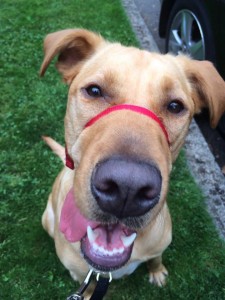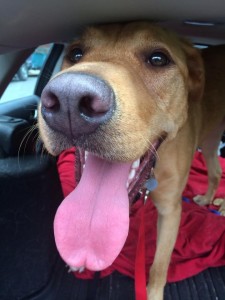Kristen is an OHS volunteer who works with dogs in the OHS Behavior Modification Program. We asked her to tell us about her work with Tate, a young dog who needed help learning to be calm.

How to Help A High-Energy Dog
I had worked with excitable, mouthy dogs before. I like helping these dogs learn self-control and appropriate play. But I knew Tate would be a tough case. This seventy-pound, strong, golden-brown Lab mix was excitable. He was mouthy. He bit leashes. He jumped on people. It took two people with two leashes just to walk him down the hall outside his kennel. Did I mention that he was also adorable, with soft fur and pretty eyes?
Tate the Wrestler
During our first training session, I discovered that Tate was a wrestler. Another volunteer and I had brought him into the OHS “Real Life Room,” where there are couches, pillows and toys that simulate an average living room. I started the session by asking Tate to sit, but he was far too excited at being in a new place, and he jumped up on me, mouthing at my arms and clothes. It was as if he had been taught to wrestle as a puppy, but then he got too big and strong. However, the behavior was already ingrained. The other trainer had to step in to assist me before Tate had me down for the count. It was clear Tate had a lot to work on.
In light of Tate’s strength and wrestler moves, we assembled a team of people to work with him daily. I paired up with another volunteer and we worked with Tate twice a week. We used tasty wet food to reward him for being calm, and when he got too amped up and mouthy, we turned our backs and walked away. We worked on the basics—sit, down, and drop it—to engage his brain and bring him back from the brink of being over-the-top excited. Each member of Team Tate worked on getting him used to a head halter to make it easier to walk this dog who was definitely strong enough to pull me over.
Joining the Running Team

It took several weeks of working with half a dozen people, but Tate was improving by controlled leaps and bounds: he would sit for treats, walk next to us when he was wearing his head halter, and turn away from distractions He was ready for the next step: joining the OHS running team.
I decided to complete the safety and handling training required to join the OHS running team so I could take Tate out once or twice a week. I partnered with an experienced running volunteer, and we ran with Tate together on a head halter and harness. It must have looked funny to passersby who saw us both hitched to the same dog. It helped, though, and after a few weeks, he’d improved so much that I could take him out on my own and trust that he would stay by my side instead of rushing down the sidewalk.
Going Home
Tate’s progress was slow and steady, but because of Team Tate’s consistent positive reinforcement and guidance, the lessons he learned stuck with him. Our last sessions together were devoted to learning how to behave in a home. We were back in the Real Life Room, and I brought reading material. All Tate had to do was rest beside me on the couch, like he hopefully would in his new home. He was able to do this while I read and stroked his forehead.
The difference Team Tate made for that dog was immense. He had gone from mouthy, jumpy, over-the-top excitable to a dog that could walk nicely on leash, settle on a bed, and play appropriately with his toys. He found the perfect adopter in late summer of 2014, a patient person who was made aware of all Tate’s most challenging qualities. She asked great questions and kept up with his training so he wouldn’t forget his new manners.
Helping a challenging dog like Tate discover his best self and matching him to a great adopter is the most rewarding part of volunteering with the behavior department. Tate’s improved manners helped him find an excellent, lasting match. While it was hard to say goodbye, I’m thankful that I got the chance to work with him. I learned so much and I know I’ll be ready to help the next “Tate” find his new home.
-contributed by Kristen Hall-Geisler, OHS volunteer and Training Assistant
More Information
Learn more about the OHS Behavior & Training Department »


